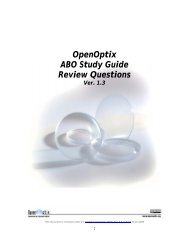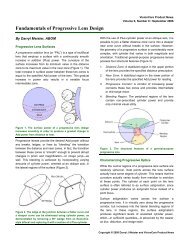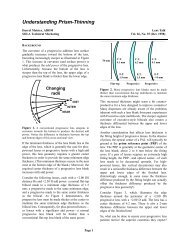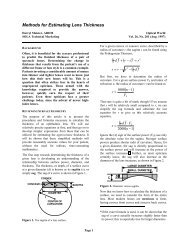OpenOptix ABO Study Guide - Laramy-K Optical
OpenOptix ABO Study Guide - Laramy-K Optical
OpenOptix ABO Study Guide - Laramy-K Optical
You also want an ePaper? Increase the reach of your titles
YUMPU automatically turns print PDFs into web optimized ePapers that Google loves.
Light reaches its final destination at the retina. The retina consists of photoreceptor cells<br />
called rods and cones. Rods are highly sensitive to light and are more numerous than<br />
cones. There are approximately 120 million rods contained within the retina, mostly at<br />
the periphery. Not adept at color distinction, rods are suited to night vision and peripheral<br />
vision. Cones, on the other hand, have the primary function of detail and color detection.<br />
There are only about 6 million cones contained with in the retina, largely concentrated in<br />
the center of the retina called the fovea. There are three types of cones. Each type<br />
receives only a narrow band of light corresponding largely to a single color: red, green, or<br />
blue. The signals received by the cones are sent via the optic nerve to the brain where<br />
they are interpreted as color. People who are color blind are either missing or deficient in<br />
one of these types of cones.<br />
Refractive Errors<br />
Refractive errors occur when abnormalities of the eye prevent the proper focus of light on<br />
the retina. Emmetropia refers to an eye free of refractive errors.<br />
Two common types of refractive errors are myopia and hyperopia.<br />
This document is licensed under the Creative Commons Attribution 3.0 License. 7/30/2009<br />
8









